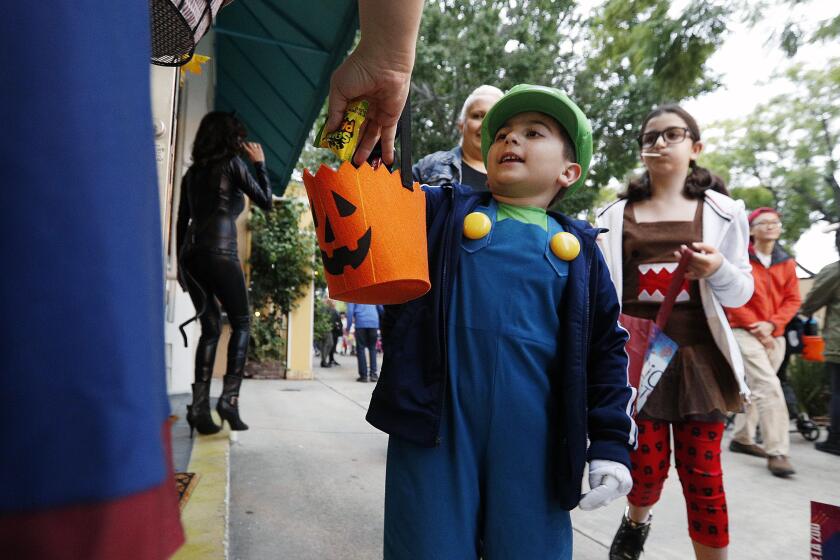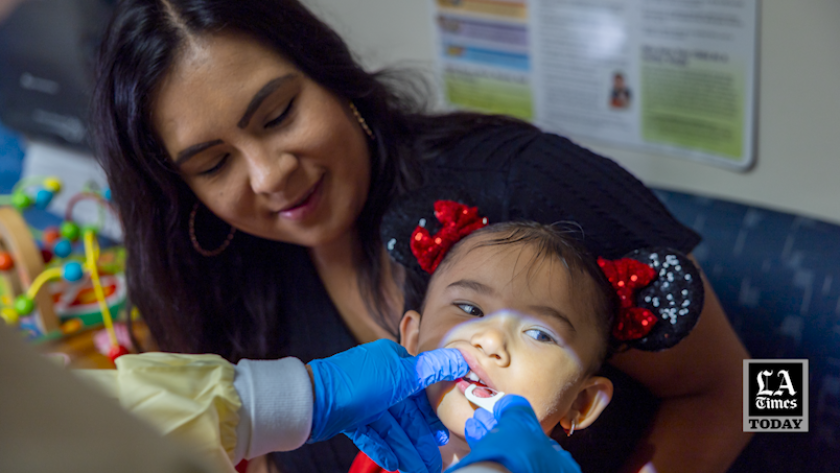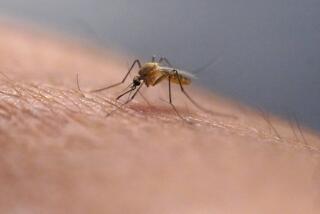California kids have some of the worst teeth in the nation. Here’s why
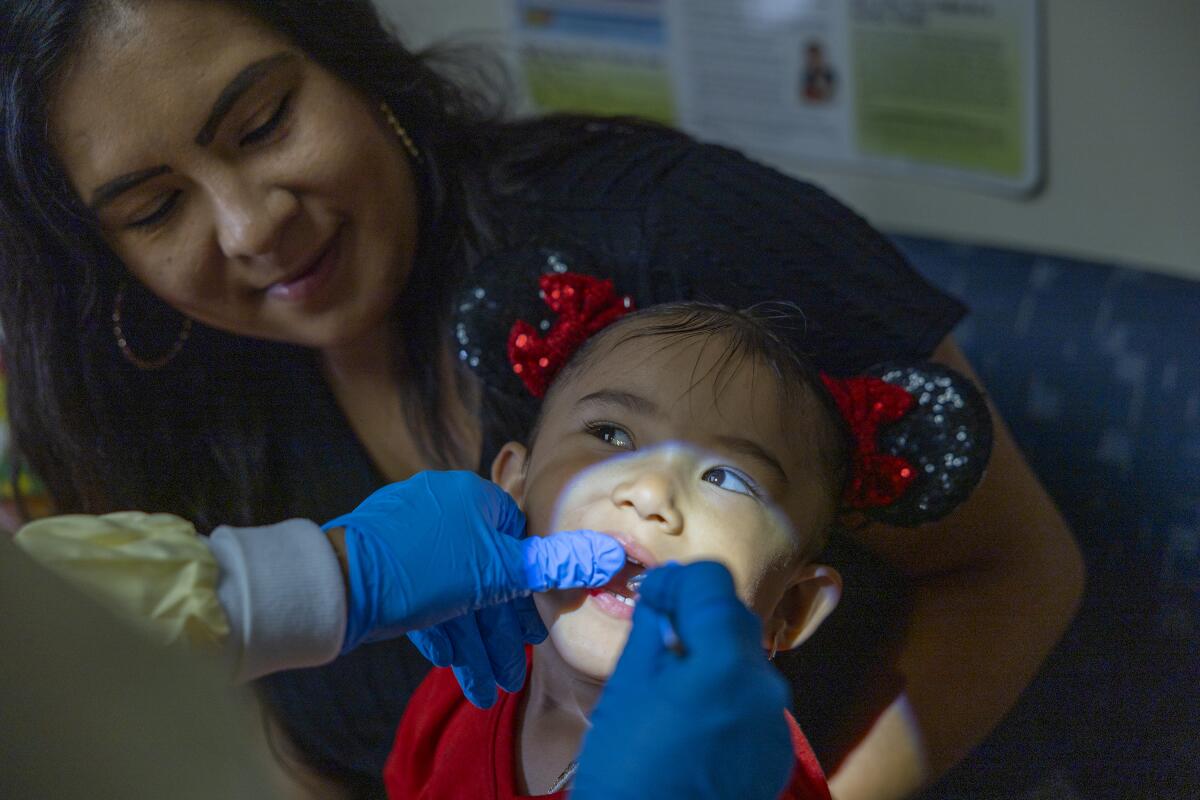
Long Beach — Priscilla Serrano did everything she could to keep her child’s teeth clean and healthy. She rubbed his gums twice a day with a finger brush when he was 3 months old. She brought him to the dentist before his first birthday. She weaned him off a bottle early, gave him healthful snacks, avoided juice, brushed his teeth twice a day, and even flossed for him.
But despite her best efforts, Daniel still developed two cavities before his 6th birthday.
“I was kind of devastated. You work so hard to prevent any of this, and then you see your child in pain,” said Serrano of Long Beach. “I was in denial at first. I was like, ‘No, I did a good job.’ But I finally accepted.”
At the time of year described by dentists as the scary season for teeth — a Halloween holiday laden with sticky, sugary treats — children’s dental care takes on a sense of renewed urgency. The stakes couldn’t be higher in California, where the health of little teeth is sobering.
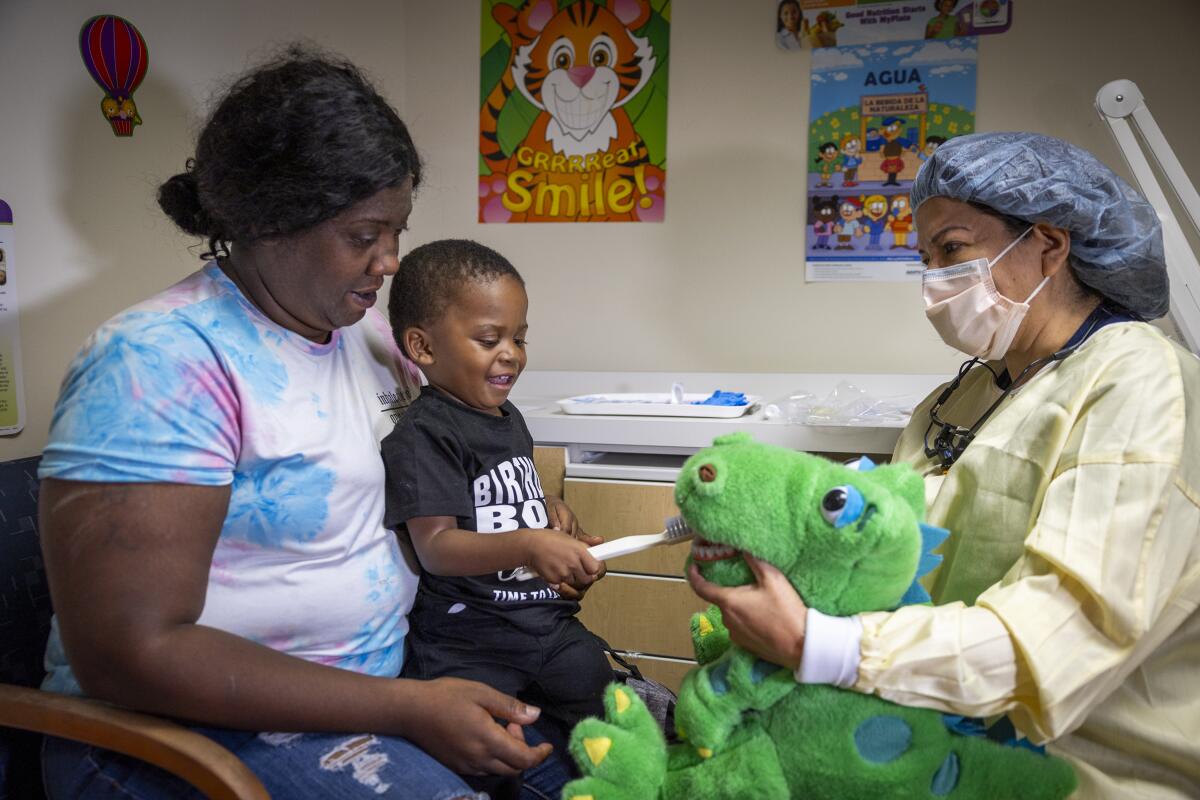
California ranks among the worst states when it comes to pediatric dental disease. A national survey from 2020-21 found that 14.8% of the state’s children ages 1 to 17 had decayed teeth or cavities in the past 12 months studied — ranking 47th out of 51 among all the states and the District of Columbia.
“We’re really pushing for prevention because we don’t want to go down the line of having cavities, oral pain, possible infection and spread of infection,” said Dr. Abrey Daniel, a dentist with the Oral Health Program at the Los Angeles County Department of Public Health. “Sometimes parents may just do a quick brush and not even notice that cavities are forming.”
Nationwide, more than half of children develop cavities by the age of 8, usually because of poor nutrition, bad hygiene habits or a lack of dental care. Other factors include drinking water without fluoride, inadequate saliva flow and genetics; even a child with good dental habits can develop cavities.

Subscribers get exclusive access to this story
We’re offering L.A. Times subscribers special access to our best journalism. Thank you for your support.
Explore more Subscriber Exclusive content.
As with so many health issues, children from socioeconomically disadvantaged families are most at risk. The California Department of Public Health’s 2018-19 Smile Survey of third-graders found that children from communities of color and Spanish-speaking households are more likely to experience tooth decay. Latino children had the highest rates, with 72% having experienced some sort of tooth decay, compared with 40% of white children. Black children had the highest rate of untreated decay at 26% — almost twice the rate of white children.
Throughout the state, many low-income children have limited access to dental care, fresh fruits and vegetables, and fluoridated tap water, said Dr. Ryan Huang, the dental director at the South Central Family Health Center. Less than 60% of the population across California receives fluoridated water, according to the CDC.
Brushing twice a day with fluoride toothpaste is also crucial, yet many California children aren’t meeting that threshold, said Huang. Some families can’t even afford to buy toothpaste or toothbrushes, and others don’t know the basics of dental hygiene. “There’s a lack of proper education not just with the children, but with the parents too,” Huang said.
The state in recent years has worked to improve its dental insurance program for the poor — which was harshly criticized in 2016 by the Little Hoover Commission for failing to provide adequate care to half of the state’s children. Few dentists in the state accepted the insurance, the commission reported, due to low reimbursement rates and bureaucratic red tape, leaving many low-income California kids without access to dental care.
Only about half of eligible children saw a dentist annually because so few dentists would see them, compared with two-thirds of children with commercial insurance, the commission found. Since then, the state has increased payment rates for dentists in an effort to improve access for patients.
Subscriber Exclusive Alert
If you're an L.A. Times subscriber, you can sign up to get alerts about early or entirely exclusive content.
You may occasionally receive promotional content from the Los Angeles Times.
A 2022 state survey of Medi-Cal dental providers found that 54% said the average wait time for a non-urgent appointment was less than one week; 40% said the wait was one to three weeks. The 2018-19 Smile Survey found that rates of decay had declined over the previous decade, but were still well above national data. In California, 61% of third-graders had experienced tooth decay, compared with the national median of 53% among states.
Dentists say the rates of decay likely worsened during the pandemic, when many children skipped dental appointments.
Accessing Medi-Cal dental care remains difficult in some parts of the state, including rural areas and even some ZIP Codes in L.A., where there is still a shortage of dentists that accept the coverage.
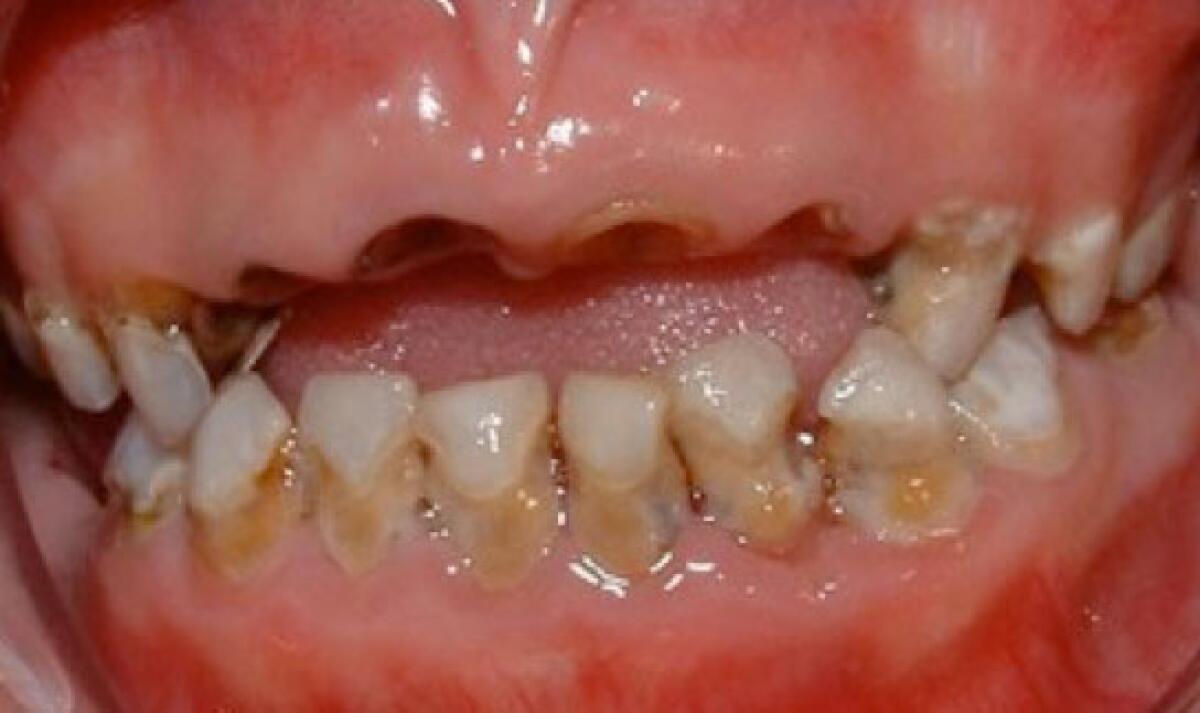
L.A. County’s Smile Survey, which was conducted by the public health department, found that on any given day, more than 4,500 Los Angeles County kindergarten and third-grade children need urgent dental care, which means they may be experiencing mouth pain or a serious infection. Elementary students at L.A. Unified missed an average of 2.1 days of school because of dental issues, according to a 2011 study from the University of Southern California.
State law requires parents of kindergartners to submit proof of an oral health assessment, but the mandate is not enforced. Parents are allowed to fill out a waiver explaining that they did not complete the assessment for various reasons, including being unable to find a dental provider, said Eileen Espejo, who leads the oral health project at Children Now.
There are efforts to screen and treat students who don’t have access to care through dental clinics at schools, including at LA Unified, with help from local nonprofits and county health departments. But the available resources do not come close to meeting the needs of students.
The importance of healthy baby teeth
Dentists say that waiting until a child is of school age is much too late to begin regular dental checkups.
“A lot of parents have the misconception that baby teeth will fall out and aren’t important, but it’s the best predictor of oral health for adults,” Daniel said.
Baby teeth are crucial to speech development, proper nutrition and jaw formation. Problems can cause long-term complications for a child’s overall health and well-being. Cavities in baby teeth can spread to the permanent teeth waiting to push through. And severe untreated decay can lead to broken teeth, abscesses and, in extreme cases, even death.

And because baby teeth have a thinner outer shell of enamel, which allows bacteria to eat through them faster, they are even more susceptible to cavities than the permanent teeth that replace them. Before the pandemic, 5% to 7% of Kindergartners screened at L.A. Unified schools had severe dental disease requiring emergency treatment, according to the L.A. Trust for Children’s Health, which brings dental care to LAUSD schools. After the pandemic, that number had grown to 7% to 10%.
Cavities can form even earlier. In extreme cases, baby teeth erupt in infants with cavities already formed. At UCLA, there’s a six-month wait for surgery for treatment of severe cases of tooth decay requiring anesthesia, said Dr. Francisco Ramos-Gomez, director of the UCLA Center for Children’s Oral Health.
Vigilant care for baby teeth and those first permanent teeth falls squarely on parents and caregivers, and their early practices will have long-lasting ramifications for a child’s future dental health.
A surprisingly long list of dos and don’ts
The recommendations for baby teeth hygiene go far beyond just brushing twice a day and avoiding lollipops. Some of recommendations are well known: Brush twice a day. Avoid sticky candy that’s difficult to remove from teeth, as well as sugary juice and soda. Don’t let your child fall asleep with a bottle of milk. Visit a dentist by the time a child is 1 year old, and make sure a child receives a fluoride treatment.
Other recommendations are also important, but lesser-known and cumbersome.
From the time a baby is born, for example, dentists advise that caregivers begin wiping their gums with a clean cloth after feedings. Some dentists advise wiping even after middle-of-the-night feedings, while others say twice a day is plenty.
“If the baby is sleeping, the last thing I’m going to do is jam a finger in their mouth,” said Dr. Lisa Berens, a professor at the UC San Francisco School of Dentistry. “It’s more to get them habituated to the feeling of something in their mouth.”
Brushing should be done early and often. When the first tooth appears, dentists say, begin brushing with a small smear of fluoride toothpaste on a baby toothbrush twice a day — just enough to color the bristles — and avoid so-called training toothpastes that do not have fluoride.
“Training toothpaste is garbage because it gives a false sense of security to parents,” Ramos-Gomez said. “It doesn’t work.”
Meanwhile, caregivers should begin flossing when the child has two adjacent teeth that are touching, or by the age of 5, and continue brushing their child’s teeth for them until age 8. “Even if the child doesn’t want to, you have to,” Ramos-Gomez said.
Nutrition is also key. Children should minimize snacking to three times a day or less and seek to avoid not only candy but all sticky foods, including dried fruits such as raisins and gummy vitamins, which tend to adhere to teeth and are difficult to wash away. Ramos-Gomez also recommends skipping baby food contained in popular pouches, which is often high in sugar, and the puree is more likely to sit on a child’s teeth before being washed away. “Pouches and cavities go hand in hand,” he said.
Dentists remind caregivers to give children fluoridated tap water rather than bottled water, to help stave off decay. And avoid sharing saliva with children or even blowing on their food. The bacteria that cause cavities can be spread from an adult’s mouth.
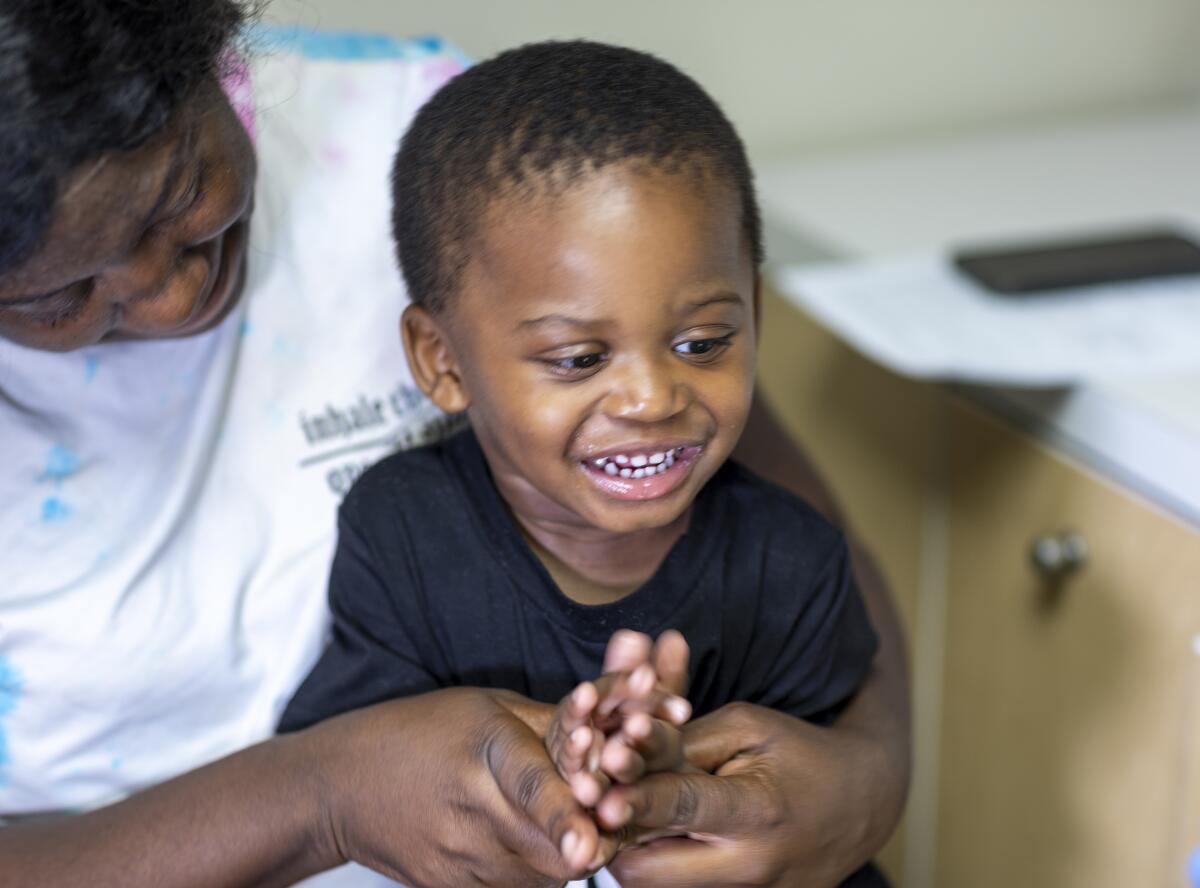
How a child’s dental exam is different
On a recent October day, a parade of young children came through the doors of the Children’s Dental Health Clinic in Long Beach to take part in a special cavity prevention program for children 5 and younger.
Armani Allen, 2, walked in wearing a “Birthday Boy” T-shirt and a big smile, accompanied by his mom, Nicole Nelson. This was his third visit to the Oral Health Education Center.
First, dental hygienist Elizabeth Valdivia, who runs the program, sat down to talk about prevention strategies with Nelson, while Armani played with a wooden activity cube. At each visit, the parents set two goals for improved dental hygiene. So Valdivia began by checking in. Had Nelson been able to offer less juice and brush Armani’s teeth more often?
She successfully cut his juice down to a few cups a week, Nelson said, but brushing is still hard. Armani has been fighting her, especially in the morning when he’s “cranky,” closing his mouth and refusing to let her brush. But she’s trying, using the fluoride toothpaste the clinic recommends, and even flossing.
Valdivia asked about what snacks Nelson was feeding her son. The fruit strips Nelson bought are too sticky and sweet, Valdivia tells her gently, even though they are labeled “organic.”
Finally, it was time to examine Armani’s teeth. He’s too young for a big dentist’s chair. Instead, he sits in his mom’s lap while Valdivia sits across from them. Armani is an excellent patient, allowing Valdivia time to clean and examine his tiny teeth, then paint on a quick coat of fluoride varnish.
Nelson said she’s learned some new tips for Armani. “The chewy stuff like Starburst candy — I didn’t know how bad that was because it sits on the teeth,” she said. “I thought he was too young to floss, too. I didn’t know about that.”
About 90% of the patients at the Long Beach clinic are on Medi-Cal, which serves children from low-income families.
“Our population has a lot of troubles at home. We understand that their environment sets them up for the worst-case scenario for cavities,” said Dr. John Blake, the clinic’s executive director and president of the California Dental Assn.
Blake said the prevention program has been a lifeline to families at the clinic. “When we’re able to spend some quality time, many of them kind of get it,” Blake said. “It’s an ‘a-ha’ moment, and they make some changes at home. It makes a world of difference.”
This article is part of The Times’ early childhood education initiative, focusing on the learning and development of California children from birth to age 5. For more information about the initiative and its philanthropic funders, go to latimes.com/earlyed.
Watch L.A. Times Today at 7 p.m. on Spectrum News 1 on Channel 1 or live stream on the Spectrum News App. Palos Verdes Peninsula and Orange County viewers can watch on Cox Systems on channel 99.
More to Read
Subscriber Exclusive Alert
If you're an L.A. Times subscriber, you can sign up to get alerts about early or entirely exclusive content.
You may occasionally receive promotional content from the Los Angeles Times.
